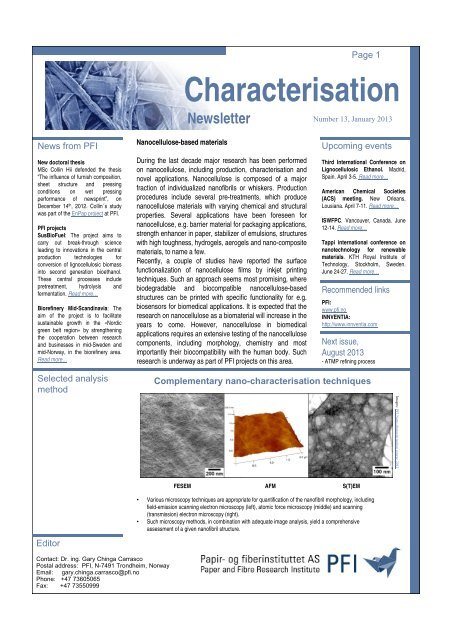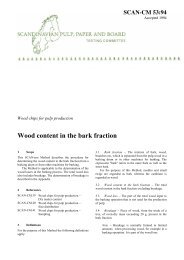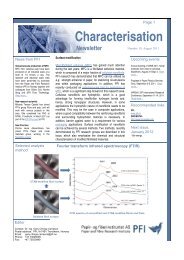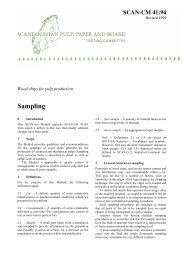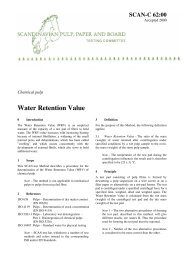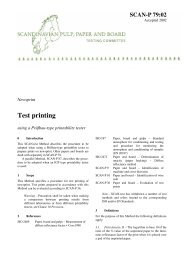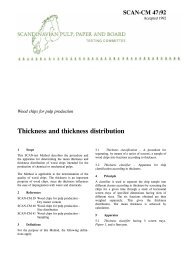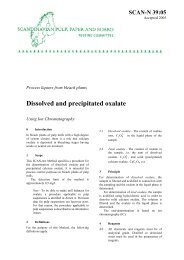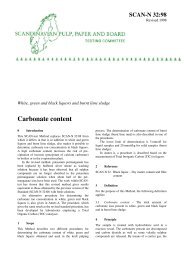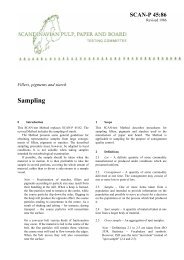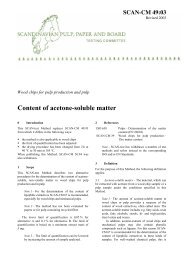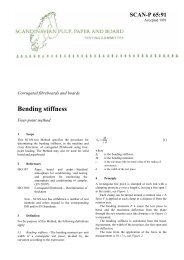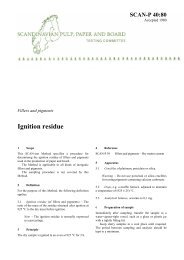Nanocellulose-based materials - PFI
Nanocellulose-based materials - PFI
Nanocellulose-based materials - PFI
- No tags were found...
Create successful ePaper yourself
Turn your PDF publications into a flip-book with our unique Google optimized e-Paper software.
Page 1CharacterisationNews from <strong>PFI</strong>New doctoral thesisMSc Collin Hii defended the thesis“The influence of furnish composition,sheet structure and pressingconditions on wet pressingperformance of newsprint”, onDecember 14 th , 2012. Collin´s studywas part of the EnPap project at <strong>PFI</strong>.<strong>PFI</strong> projectsSusBioFuel: The project aims tocarry out break-through scienceleading to innovations in the centralproduction technologies forconversion of lignocellulosic biomassinto second generation bioethanol.These central processes includepretreatment, hydrolysis andfermentation. Read more…Biorefinery Mid-Scandinavia: Theaim of the project is to facilitatesustainable growth in the «Nordicgreen belt region» by strengtheningthe cooperation between researchand businesses in mid-Sweden andmid-Norway, in the biorefinery area.Read more…Newsletter<strong>Nanocellulose</strong>-<strong>based</strong> <strong>materials</strong>During the last decade major research has been performedon nanocellulose, including production, characterisation andnovel applications. <strong>Nanocellulose</strong> is composed of a majorfraction of individualized nanofibrils or whiskers. Productionprocedures include several pre-treatments, which producenanocellulose <strong>materials</strong> with varying chemical and structuralproperties. Several applications have been foreseen fornanocellulose, e.g. barrier material for packaging applications,strength enhancer in paper, stabilizer of emulsions, structureswith high toughness, hydrogels, aerogels and nano-composite<strong>materials</strong>, to name a few.Recently, a couple of studies have reported the surfacefunctionalization of nanocellulose films by inkjet printingtechniques. Such an approach seems most promising, wherebiodegradable and biocompatible nanocellulose-<strong>based</strong>structures can be printed with specific functionality for e.g.biosensors for biomedical applications. It is expected that theresearch on nanocellulose as a biomaterial will increase in theyears to come. However, nanocellulose in biomedicalapplications requires an extensive testing of the nanocellulosecomponents, including morphology, chemistry and mostimportantly their biocompatibility with the human body. Suchresearch is underway as part of <strong>PFI</strong> projects on this area.Number 13, January 2013Upcoming eventsThird International Conference onLignocellulosic Ethanol. Madrid,Spain. April 3-5. Read more…American Chemical Societies(ACS) meeting. New Orleans,Lousiana. April 7-11. Read more…ISWFPC. Vancouver, Canada. June12-14. Read more…Tappi international conference onnanotechnology for renewable<strong>materials</strong>. KTH Royal Institute ofTechnology, Stockholm, Sweden.June 24-27. Read more…Recommended links<strong>PFI</strong>:www.pfi.noINNVENTIA:http://www.innventia.comNext issue,August 2013- ATMP refining processSelected analysismethodComplementary nano-characterisation techniquesImages: <strong>PFI</strong> Nano-characterisation course 2012EditorFESEM AFM S(T)EM• Various microscopy techniques are appropriate for quantification of the nanofibril morphology, includingfield-emission scanning electron microscopy (left), atomic force microscopy (middle) and scanning(transmission) electron microscopy (right).• Such microscopy methods, in combination with adequate image analysis, yield a comprehensiveassessment of a given nanofibril structure.Contact: Dr. ing. Gary Chinga CarrascoPostal address: <strong>PFI</strong>, N-7491 Trondheim, NorwayEmail: gary.chinga.carrasco@pfi.noPhone: +47 73605065Fax: +47 73550999
Page 2CharacterisationNewsletter Number 13, January 2013Electrically conductivestructuresInkjet-printed silver-nanoparticles on nano-engineered cellulose films forelectrically conducting structures and organic transistors – concept andchallengesAbstractThis study explores the suitability of microfibrillated cellulose (MFC) films as a substrate for printing electrically conductivestructures and multilayer electronic structures such as organic field effect transistors (OFET). Various MFC qualities weretested, including mechanically produced MFC, 2,2,6,6-tetramethylpiperidinyl-1-oxyl (TEMPO) pre-treated MFC andcarboxymethylated-MFC. The films differed significantly with respect to the surface structure. In addition, thecarboxymethylated-MFC films were surface modified with hexamethyldisilazane (HMDS) in order to reduce the waterwettabilityof the films and thus improve the print resolution of the inkjet printed silver (Ag) nanoparticles.The Ag-particles (diameter


